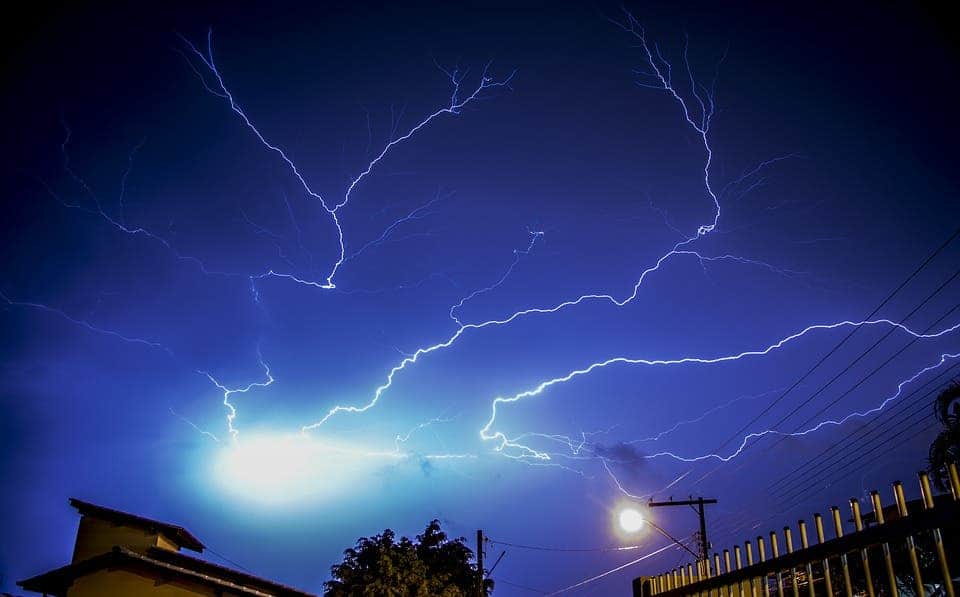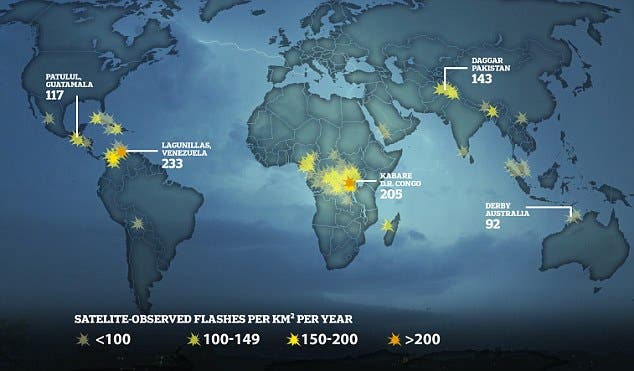
Each year, on average, 48 people from the United States get killed after being struck by lightning. Is that a lot? To answer this question you have to put the fatality count in relation to the frequency of lightning strikes. According to the National Severe Storms Laboratory, each day the planet is hit by eight million lightning strikes but not all places get pounded equally the same. Now, a new analysis of satellite imagery offers the best estimates so far of lightning prone area from all around the world.
Using data gathered between 1997 and 2015 by a satellite called the Tropical Rainfall Measuring Mission, scientists made a list of the top 500 places most hit by lightning. The tally was organized based on the number of flashes observed per square kilometer per year. Only locations that were under the satellite’s instruments could be measured, a path that included every spot between 38°N (Athens, Greece) and 38°S (Melbourne, Australia).
According to the analysis, you should stand clear of Lake Maracaibo, Venezuela, where thunderstorms loom 297 nights each year. One square kilometer of Lake Maracaibo receives 233 flashes of lightning each year, more than any other place on Earth.

What makes Lake Maracaibo such a big lightning hot spot is its geography which favors the formation of thunderstorms. The lake is surrounded by lofty peaks, whose cold air clashes with the warm tropical waters of Maracaibo, a situation which we can also find in lakes Victoria and Tanganyika in Africa, two other massive lightning hot spots.
Even long before we had these satellite imagery analyzed, people knew the Venezuelan lake — sometimes called the most electric place on Earth — is one of the most lightning prone areas around the world from anecdotal evidence alone. The lightning is so consistent year round here that for centuries ships have used Lake Maracaibo as a natural lighthouse for navigation purposes. The flashes of light around Maracaibo even helped thwart two invasions. The first attempt was in 1595 when it illuminated ships led by Sir Francis Drake of England, revealing his surprise attack to Spanish soldiers in Maracaibo. The other was during the Venezuelan War of Independence in 1823, when it betrayed a Spanish fleet trying to sneak ashore.
https://www.youtube.com/watch?v=tHzujX8mkhw
Despite Maracaibo taking the top spot, the new study suggests that Central Africa is where you can find the most lightning prone areas. Here, broad areas are afflicted by thunderstorms and 283 of the world’s top 500 spots reside.
Other important findings worth mentioning include:
- Low-latitude areas experience far more lightning than higher-latitude areas.Tropical regions can get hit by lightning strikes year-round whereas northern latitudes experience lightning only half that time.
- Although a lake seeks the most lightning flashes, lightning occurs more frequently over land than over oceans and lakes, more in the summer than in the winter, and most often between noon and 6 P.M.
- Africa is the continent with the most lightning hotspots, followed by Asia, South America, North America, and Australia.
- Most of the principal continental maxima are located near major mountain ranges, revealing the importance of local topography in thunderstorm development.


